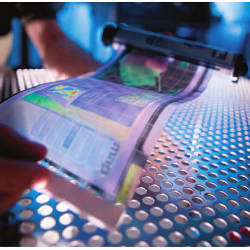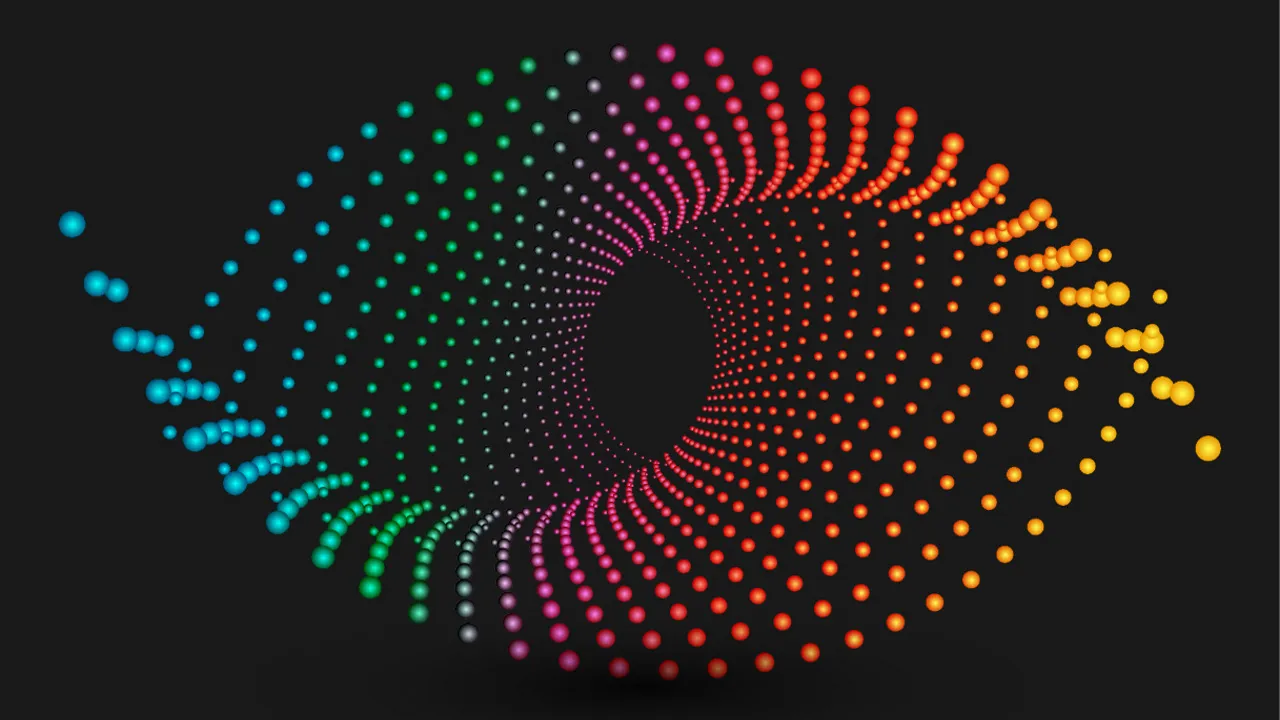
Ever since scientists first hacked oscilloscopes in the 1950s, computer displays have been heavy, fragile things. Even in a super-thin laptop, the quarter-kilogram screen is one of its heaviest parts—and the case required to protect it adds further bulk and weight. The screen also defines the form factor of most electronic devices as it’s a single component that’s rectangular, flat, and unbendable.
Now several developments portend an industrywide change to displays that are lighter, tougher, and more flexible than the sheet glass of a traditional liquid-crystal display (LCD). These displays are just beginning to appear on the market, and are produced with methods that may also improve energy efficiency, lower production costs, and allow for display shapes and sizes currently impossible to achieve.
Already these displays have started to appear in a variety of applications. The 75th anniversary issue of Esquire magazine gave them wide exposure by featuring e-paper that blinked “The future is now” on its front cover. Other uses already in the market include keyboards with auto-changing layouts, low-power shelf tags and point-of-sale ads, and display windows on credit-card-size smart cards. But designers are also rethinking product design around these new screens’ possibilities. Carl Taussig, director of Advanced Display Research at Hewlett-Packard, notes the Dutch company Polymer Vision has demonstrated a cell phone with a rollout display, and suggests other possible form factors. “You might have a display that you keep folded up like a piece of paper,” Taussig says. “You might open it halfway and use it that way, or you might open it all the way. You might have it partitioned with a keyboard on one part and a screen on the other.”
Front Plane, Back Plane
These new display technologies comprise two parts: a front plane that contains the imaging component, and a back plane that controls which pixels are on. For a display to be fully flexible, both parts must have that characteristic. While dozens of companies are competing to provide back planes, two front plane technologies have taken the lead.
One is electronic paper, or e-paper, like that used in the Amazon Kindle, Barnes & Noble Nook, and Sony Reader Digital Book. The producer of the e-paper in all three devices is the Massachusetts-based E Ink Corporation. Those devices currently pair the flexible display layer with an inflexible glass back plane. E-paper is a reflective display; its brightness comes from ambient light hitting the display’s face, as on a sheet of paper. Pixels in E Ink’s e-paper are electrically dipolar units colored white on one side and black on the other, floating in thick oil. Their refresh rate is currently quite low, at about four frames per second. E-paper is bistable, retaining its image until it receives the next signal. As a result it consumes energy only when transitioning from one image to the next.
The other front plane technology is organic light-emitting diodes (OLEDs), which emit rather than reflect light. OLED displays consume more power than e-paper, but are brighter and have faster refresh rates. They have a higher lumen-per-watt rating—that is, they use less power for comparable brightness—than comparable LCDs because the latter cause liquid crystals to block photons coming from a backlight. On the other hand, OLEDs actually emit light themselves.
Nick Colaneri, director of the Flexible Display Center at Arizona State University, believes OLED displays may eventually consume as little as 1/10th the power of LCDs, even as they deliver “a kind of intangibly superior image quality. Put side-by-side, OLED displays are often seen as strikingly better looking.” That makes them a likely challenger in the $100 billion LCD industry, although OLED displays are extra difficult to ruggedize because they’re far more sensitive to oxygen and moisture. (E-paper is more likely to be used in applications where pow-er and reliability trump brightness and contrast.)
Some manufacturers have proposed trying to capture both markets with hybrid transflective versions based on e-paper, similar to the Pixel Qi LCD screen on One Laptop Per Child’s XO computer. That screen includes both a backlight for low-light situations and a reflective layer for easy reading when the sun is out. Transflective displays with e-paper or OLED front planes are not currently available, but they’re possible because the back plane could be made from reflective or transparent materials.
Flexible displays will have fast growth during the next several years, but won’t become mainstream before 2018, says Jennifer Colegrove.
With their similarity to LCDs, the potential rewards for OLED displays are enormous. At the same time, e-paper is defining new market segments, notably in portable electronics and large-scale signage. According to Jennifer Colegrove, vice president of emerging display technology at DisplaySearch, flexible plastic displays will grow at an annual rate of nearly 60%, surpassing $8 billion in sales in 2018 from its current level of about $300 million. Colegrove believes that although flexible displays will have fast growth in the next several years, they won’t become truly mainstream before 2018, both because of technical problems and the task of making them cost competitive with traditional glass-based displays.
Beyond Rectangular Thinking
Commercial products are available for both e-paper and OLED displays, including e-readers and advertising displays. Today, e-paper claims far greater market pull than OLED, largely because of e-readers. But Sriram Peruvemba, E Ink’s chief marketing officer, points to other uses for e-paper that weren’t possible with previous display technologies. “Most requests I get from design engineers are for rectangular displays, because that’s all they were able to get before,” says Peruvemba. “I tell them, ‘Think outside the rectangle.’ With our flexible display, you can cut it in any shape, so it’s only limited by imagination. Right now the device has to accommodate the display, but in the future the display will accommodate the device.”
Shape isn’t the only feature available to this new breed of displays but unavailable to LCDs. Because an LCD’s transparent electrodes must remain a set distance apart, they can’t be flexible, and are therefore made of thick, rigid glass. Transporting large sheets of glass is difficult and expensive, so LCDs are generally limited to a few square feet in size. But flexible displays can be made on material that’s stored and shipped in a roll, much like a web-fed paper press, enabling display sizes of a few meters wide by hundreds of meters long.
But with that flexibility are some practical problems. “How do you handle flexible substrates for TFT [thin-film transistor] manufacturing?” Colegrove of DisplaySearch has asked. “Glass is easy: It’s a rigid sheet, and you just put layers on it. But with flexible displays it can be hard to register for the very accurate positioning you need. Also, some plastics deform when you heat them up, which can affect manufacturing. Therefore, several new processes have been invented.”
To address registration problems, some manufacturers have championed a roll-to-roll process that allows them to print electronics with greater precision than traditional photolithography allows. Photolithography is an “exposure” system: Light affects chemistry that etches electronics, similar to how an old-fashioned photo enlarger affects an image on paper. By comparison, the roll-to-roll process places electronics directly on a substrate and is more similar to a modern inkjet printer.
Hewlett-Packard’s explorations with unusual form factors led it to close a contract with the U.S. Army for wrist-mounted devices that would make critical information more easily available to soldiers in the field. As designed, the devices are only about 1.5mm thick and feature a screen that curves halfway around the wrist, the other half being a set of flexible photovoltaic cells to provide power. Taussig expects to deliver prototypes to the Army by this autumn, and sees viability for such devices well beyond its first customer.
“We imagine a lot of use cases,” he says. “[A flexible plastic screen] could be built into the cuff of a delivery driver’s uniform and include mapping information and the like. Or maybe it’s for a mechanic or technician who’s assembling jet aircraft, and won’t have to go back to a table to see a schematic. Or a health-care technician or nurse could keep track of medication and patients and such. It’s very hands free. If it gets smashed into a door it’s not going to break. It’s very low power, and it’s light.”
Hewlett-Packard’s devices will be built with E Ink’s e-paper displays on a plastic substrate. But plastic wouldn’t work for OLED displays as its permeability would doom the sensitive OLEDs to a short life. For those applications, Corning Inc. is developing a kind of flexible glass by extending its proprietary fusion process, which it already uses to create thin glass substrates such as the Eagle XG line. While glass is necessarily heavier and more sensitive to certain stresses, Corning flexible glass commercial program manager Jill VanDewoestine believes the industry will respond well to this development because of glass’ distinctive qualities.
“Glass is really the standard,” VanDewoestine says. “Its surface is very smooth; it’s stable; high process temperatures are possible; it’s transparent; and it’s an excellent barrier against oxygen and moisture. So people really want to work with flexible glass—it gives them the handle-ability of roll-to-roll processes with the characteristics of glass that make high-quality electronics possible.” The company is currently developing flexible glass that’s 1/10th of a millimeter thick and can be wrapped around a core with a three-inch radius.
But whether incorporating glass, plastic, or some other material, flexible display technologies represent the leading edge in changing the shape of computing devices. Consider the laptop computer, which in essence comprises a screen, keyboard, and processor. Flexible rubber keyboards are already available at big-box stores, and several manufacturers make “virtual keyboards” that project laser images of the keys onto any flat surface. Flexible plastic electronics are in active development, with the Russian corporation Rusnano recently announcing development of a $700 million factory to produce such electronics. The age of the Dick Tracy wrist computer is already upon us. With flexible displays leading the way, there’s no limit to the shapes of computers to come.
Chung, I.-J. and Kang, I.
Flexible display technology—opportunity and challenges to new business application, Molecular Crystals and Liquid Crystals 507, Sept. 2009.
FlexTech Alliance for Displays & Flexible Printed Electronics
http://www.flextech.org/
Forge, S., Blackman, C., and Lindmark, S.
Plastic promises: the disruptive potential of OLEDs and e-paper for the European display industry, Foresight 11, 3, 2009.
Jeong, J. K.
The status and perspectives of metal oxide thin-film transistors for active matrix flexible displays, Semiconductor Science and Technology 26, 3, 2011.





Join the Discussion (0)
Become a Member or Sign In to Post a Comment